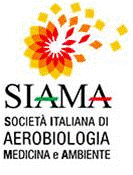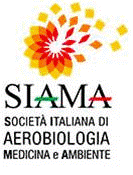The report is updated every Wednesday, and it is based on pollen data of the previous week, from Monday to Sunday. Monitoring centers, located throughout Italy and referring to the Italian Aerobiological Monitoring Network (RIMA®), collect these data. All centers use the same standardized method, by which data of daily average concentrations expressed in pollen grains per cubic meter of air (P/m3) are produced, and operate morphological identification of airborne pollen grains belonging to approximately 44 families and 37 genera, and of 19 fungal spores. The centers report the collected data to the Technical Administration of the Network every week.
Network technical administration
Network technical administration receives all weekly data from monitoring centers, perform data processing and release the reports.
How to use the report
For every family there are four classes of concentration, absent, low, medium and high, identified respectively by the colors white, yellow, orange, red.
The presence of pollen or spores belonging to a family or a genus with no determination of concentration classes is indicated in blue. Grey indicates absent data, namely if there is no pollen detection for one or more days a week. The values of the ranges of concentration classes may be different for different families. The report provides the concentration levels of pollen, not the levels of allergy risk. The onset of symptoms occurs when the concentration of pollen to which the patient is allergic reaches a threshold value. Each patient has its own threshold value of sensitization, that may also vary during season. Continued pollen exposure causes inflammation of target organs (nose, conjunctivitis, bronchitis), and reduces threshold values during season: so at the end of season also a pollen concentration lower than the beginning can trigger symptoms. This fact is called “priming effect”. Information on level pollen concentration can help, but it is always necessary getting a specialist consultation to set or change a therapy. You can find below the table of cubic meter concentration of pollen grains and relative families.
Level observed
The report information are related to the most allergenic pollen of the week. The concentration of each type of pollen is expressed in levels, in this way it is easier to read. The analysis into categories of most allergenic pollen has been developed by CNR-ISAO (see table), based on current botanical knowledge on Italian flora. For example, grass concentration is considered high if it is greater than 30 pollen grains per m3 of air, while Parietaria (Urticaceae) has a huge pollen production, so its concentration is high if it is greater than 70 pollen grains per m3 of air. In this way concentration levels of pollen recorded from Monday to Sunday are set.
Pollen concentration
Pollen per m3 of air
| Pollen | Absent | Low | Moderate | High |
| Graminaceae | 0 – 0.9 | 1.0 – 10.0 | 10.1 – 30.0 | > 30 |
| Urticaceae | 0 – 1.9 | 2.0 – 20.0 | 20.1 – 70.0 | > 70 |
| Oleaceae | 0 – 0.9 | 1.0 – 5.0 | 5.1 – 25.0 | > 25 |
| Fagaceae | 0 – 0.9 | 1.0 – 20.0 | 20.1 – 40.0 | > 40 |
| Betulaceae | 0 – 0.9 | 1.0 – 16.0 | 16.1 – 50.0 | > 50 |
| Compositae | 0 – 0.9 | 1.0 – 5.0 | 5.1 – 25.0 | > 25 |
| Corylaceae | 0 – 0.9 | 1.0 – 16.0 | 16.1 – 50.0 | > 50 |
| Cupr./Taxacee | 0 – 0.9 | 1.0 – 30.0 | 30.1 – 90.0 | > 90 |
Foresights
The report provides not only the levels recorded during the week, but also expected levels for the following days, from Wednesday (when update takes place) to Tuesday. The forecasts are developed starting from the recorded concentrations and considering many other factors including:
- historical data of daily concentration of the various pollens, developed by the AIA since 1985
- weather forecast for the current week; on rainy days the concentration of pollen in the air is considerably less because the rain brings grains to the ground.
- Climate of the current year; for example, flowering of trees is influenced by the cold period through autumn and winter, instead of herbs flowering that occurs as soon as heat accumulated in the period prior flowering.
- the significant differences between the different regions of Italy; the blooms occur first in the South than in the North; first in Eastern of Italy than in Western; first in areas near the sea with Mediterranean climate (for example, Liguria) than to internal areas.
- Winds, in particular the seasonal ones, because pollen can travel in the air for several Km.

